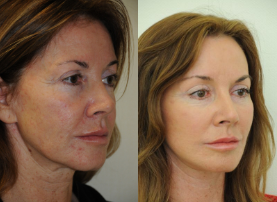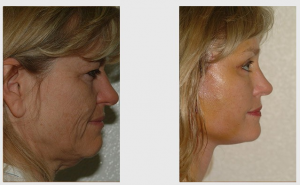What are the Benefits of a Non-Surgical Facelift
 You may have begun to show visible signs of aging on your face. A common culprit is the loss of collagen in the tissues. As we get older, collagen production slows, which can lead to weaker facial tissue and volume loss. If this occurs, you can begin to develop sagging skin or a hollow, dull appearance. In the past, it was only thought that a surgical facelift could restore the youthful contours of your face, but this is no longer the case. Dr. Calabria’s revolutionary non-surgical facelift is designed to provide patients with amazing age-reversing results without the negative side effects of a surgical facelift.
You may have begun to show visible signs of aging on your face. A common culprit is the loss of collagen in the tissues. As we get older, collagen production slows, which can lead to weaker facial tissue and volume loss. If this occurs, you can begin to develop sagging skin or a hollow, dull appearance. In the past, it was only thought that a surgical facelift could restore the youthful contours of your face, but this is no longer the case. Dr. Calabria’s revolutionary non-surgical facelift is designed to provide patients with amazing age-reversing results without the negative side effects of a surgical facelift.
What Is a Non-Surgical Facelift?
Dr. Calabria’s modern non-surgical facelift uses a patient’s own adult stem cells to rejuvenate the face. To achieve these proven, outstanding results, patient fat is harvested via liposuction and preserved in a sterile container. The fat cells are then broken down through an enzymatic process, and the adult stem cells are harvested. The adult stem cells consist of regenerative cells that help create new blood vessels and secrete growth factors.
The final step in a non-surgical facelift is injecting the stem cells into various areas of the face via micro-cannulas. The stem cells stimulate cellular turnover and regeneration. Over time, new cells will form in your facial tissue that tighten skin, smooth wrinkles, and restore lost volume.
Surgical Facelift vs. Non-Surgical Facelift
A surgical facelift creates long incisions in the hairline, and the skin is separated from the muscular layer. The deep facial tissues are then lifted vertically and held in place with internal sutures. Excess skin is trimmed away, and the remaining tissue is draped to highlight the new contours of the face. When this technique is performed by a qualified plastic surgeon, it can provide many patients with the results they desire. However, it can leave a long, visible scar, and the procedure has an extensive recovery period.
Non-surgical facelifts are designed to use tiny incisions sparingly, which results in minimal, if any, scarring. The recovery period is significantly shorter following a non-surgical facelift. The largest benefit for many patients is the slimming effect it has on other areas of the body. Since the non-surgical facelift uses patient fat harvested via liposuction, most people gain a noticeable improvement in the contours of their body. Common areas of improvement include the abdomen, hips, and thighs.
Your Non-Surgical Facelift Results
It is important to know that not every patient is an ideal candidate for the non-surgical facelift. Achieving beautiful, flawless results is dependent on you being a good patient for the procedure. Candidates with too little fat stores or severe facial sagging are not ideal candidates for a non-surgical facelift. It is important to have a consultation with board-certified plastic surgeon Dr. Calabria to determine if you are a good candidate for the procedure.
If you want to revitalize your facial appearance without extensive surgery, schedule your consultation with Dr. Calabria today. Contact our office at 888-690-4524 or fill out our online contact form for additional information.
Fat Grafting for Body Contouring
 While many patients achieve beautiful results through liposuction, the fat removal process can leave some patients with a poor appearance and surface irregularities. Overtreating a given area with liposuction can leave bumps, dents, and indentations in the surface of your skin. The results of a poor liposuction procedure are obvious and often embarrassing. Fat grafting to a previously treated liposuction area can improve your body contour and restore a more natural aesthetic.
While many patients achieve beautiful results through liposuction, the fat removal process can leave some patients with a poor appearance and surface irregularities. Overtreating a given area with liposuction can leave bumps, dents, and indentations in the surface of your skin. The results of a poor liposuction procedure are obvious and often embarrassing. Fat grafting to a previously treated liposuction area can improve your body contour and restore a more natural aesthetic.
How Fat Grafting Improves Your Contour
Fat grafting will transfer localized fat to the poorly treated area to fill in and smooth the surface. It may seem counterproductive to add fat when you wanted to remove it in the first place; however, beautifully natural liposuction results are achieved not by eliminating the most fat possible but by defining the contours of your body. Restoring areas of over-harvested fat highlights your muscles and creates attractive curves.
Benefits of Stem Cell Fat Grafting
Traditional fat grafting simply purifies the harvested fat of oil and blood to prepare it for transfer. This process is associated with low fat retention and may result in the need for repeat treatments. Stem cell fat grafting places the purified fat into a device that isolates the stem cells through an enzymatic treatment. These concentrated stem cells are more likely to remain after grafting. Stem cell fat grafting results are permanent and better improve the texture of your skin.
Additionally, the fat is harvested using a microcannula to preserve the integrity of the harvested adipose tissue. Fat used for grafting is harvested from other potential trouble areas, which provides not only correction to your poor liposuction areas but slims the rest of your physique as well.
Stem Cells for Your Face and Breasts
Fat grafting using stem cells has a wide variety of uses to enhance your appearance with natural results. Facial rejuvenation and breast enhancement have been revolutionized with the popularization of fat grafting. There is no longer the need for more invasive techniques like a facelift or breast augmentation. Instead, fat grafting uses safe, patient-harvested tissue that is injected using a fine needle. This eliminates the need for extensive incisions and prevents scarring.
If you are not satisfied with your liposuction results, schedule a consultation to see how you can benefit from body contouring using fat grafting. Contact our office at 888-690-4524 or fill out our online contact form for additional information.
Stem Cell Facelifts: Discerning the Facts From the Myths
 There is a lot of hype in the media about stem cell facelift, and it is important for a potential patient interested in a facelift or facial rejuvenation to understand what it is true and false about the procedure.
There is a lot of hype in the media about stem cell facelift, and it is important for a potential patient interested in a facelift or facial rejuvenation to understand what it is true and false about the procedure.
Plastic surgeons that are not doing stem cell facelifts disregard the procedure as “hot air.” They tell their patients that there are no advantages to using stem cells and that it is just a gimmick for marketing. This is a common attitude that many scientists have when they are faced with innovations. It usually takes time for new discoveries to get accepted.
Stem cells for facelifts and facial rejuvenation have been a topic of discussion for some time. Some other plastic surgeons claim that they are doing stem cell facelifts, but they are simply injecting fat that has been purified and not really doing anything new!
The discovery in the last decade that there was a population of adult stem cells present in the adipose tissue (fat) triggered new potential applications in regenerative medicine and the plastic surgery arena. The stem cells, along with other lines of regenerative cells, have the potential to trigger the formation of new blood vessels in the areas where they are injected and, therefore, jump start a regenerative process in the tissues. This discovery has an immense potential, but it needs to be substantiated by more data and facts.
In facelifts, the plastic surgeon has struggled for decades to deliver a natural look. Part of the problem is that the face, even if it has been lifted, still looks like an old face that has been lifted. With the introduction of the stem cells, there is a possibility that the skin itself may be rejuvenated and appear younger and fresher. This would be a monumental advance in plastic surgery.
There is some empirical evidence that fat grafting by itself can produce skin texture improvement, and there is plenty of literature to support it. Extracting the regenerative cells and stem cells from the fat is a somewhat controversial subject because the most common system to do that (enzymatic digestion with collagenase) is still not well accepted. In a true stem cell facelift, the stem cells are extracted from the fat and then re-injected in combination with the facelift procedure itself. This could potentially lead to a true rejuvenation procedure where the actual skin will look younger. More data needs to be collected, and more research needs to be done to prove some of these concepts, but regenerative medicine is here to stay.
Dr. Calabria has been on the forefront of stem cell facelifts. He has presented his stem cell facelift procedure at international meetings, has written a book chapter on the topic, and has been recognized by his peers for his innovative approach.
